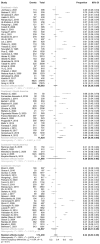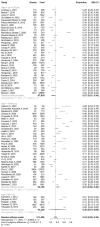A Meta-Analysis of the Global Prevalence of Temporomandibular Disorders
- PMID: 38592227
- PMCID: PMC10931584
- DOI: 10.3390/jcm13051365
A Meta-Analysis of the Global Prevalence of Temporomandibular Disorders
Abstract
Background: This meta-analysis aims to evaluate the proportion of people with TMDs in different studies, considering factors such as geographical region, patient age, and sample size. Methods: The search yielded 6984 articles on the incidence of TMDs. Finally, 74 studies with 172,239 subjects and 35,259 with TMDs were selected for final analysis. Analyses were performed using the R statistical language. Results: The incidence of TMDs in the world population was 34%. The age group 18-60 years is the most exposed to TMDs. From the data presented, we observed that for each continent, the female group was 9% to 56% larger than the male group. The highest female-to-male ratio (F:M) was reported in South America (1.56), whereas the lowest F:M ratio was reported in Europe (1.09), suggesting an almost equal distribution of males and females. Conclusions: This suggests that geographical location may play a role in the results of the studies. The prevalence of TMDs was significantly higher in South America (47%) compared to Asia (33%) and Europe (29%). Larger epidemiological studies of TMDs in African and Australian populations are recommended. In conclusion, both visual and statistical assessments suggest that the results of our meta-analysis are robust and unlikely to be significantly affected by publication bias. This suggests that geographical location may play a role in the prevalence of TMDs.
Keywords: Asia; Europe; South America; TMD; TMDs; female; meta-analysis; prevalence; temporomandibular disorders.
Conflict of interest statement
The authors declare no conflicts of interest.
Figures




References
-
- Maini K., Dua A. StatPearls. StatPearls Publishing; Treasure Island, FL, USA: 2023. Temporomandibular Syndrome. - PubMed
Publication types
LinkOut - more resources
Full Text Sources
Medical

